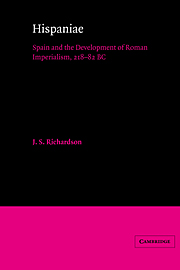Book contents
- Frontmatter
- Contents
- List of maps
- Preface
- Abbreviations
- 1 Spain and Roman imperialism
- 2 Spain before the Romans
- 3 The war zone: 218–206
- 4 Continuity and adaptation: 206–194
- 5 The shaping of the provinciae: 193–155
- 6 The consular provinciae: the wars in Spain 155–133
- 7 From provinciae to provinces: 133–82
- 8 Rome, Spain and imperialism
- Appendices
- Bibliography
- Index
6 - The consular provinciae: the wars in Spain 155–133
Published online by Cambridge University Press: 07 September 2009
- Frontmatter
- Contents
- List of maps
- Preface
- Abbreviations
- 1 Spain and Roman imperialism
- 2 Spain before the Romans
- 3 The war zone: 218–206
- 4 Continuity and adaptation: 206–194
- 5 The shaping of the provinciae: 193–155
- 6 The consular provinciae: the wars in Spain 155–133
- 7 From provinciae to provinces: 133–82
- 8 Rome, Spain and imperialism
- Appendices
- Bibliography
- Index
Summary
The next series of events in Spain which have left any substantial mark on the literary sources is the concatenation of wars waged against the Lusitanians and the Celtiberians from the mid-150s to the late 130s. For these events our only continuous account is that given by Appian in his Ibērikē, for that of Livy, whose comments on Roman activity in Spain provide most of the evidence for the late third and early second centuries, survives for this period only in the two epitomes, one known from manuscripts and one from fragments discovered among the papyri from Oxyrhyncus. Although there is considerable doubt about Appian's own sources and the historical value of his work, his narrative is coherent, and free from the excesses which from time to time mar the annalistic account given by Livy, most obviously when recording the campaigns of the Scipio brothers during the first half of the Hannibalic war. Appian arranges his material province by province rather than year by year, but a reasonably secure chronology can be extracted from it.
The first Spanish governors whom Appian mentions are the two praetors, Manilius and Calpurnius Piso, who were in Ulterior, probably in 155 and 154 respectively. These men were faced with a revolt by the so-called ‘autonomous’ Lusitanians, which was eventually put down by the ruthless and discreditable policies of Ser. Sulpicius Galba, praetor in 151, who held Ulterior in 151 and 150. The first bout of fighting in Hispania Citerior began in 153 when, after a disagreement between the senate and the town of Segeda, the consul Q.
- Type
- Chapter
- Information
- HispaniaeSpain and the Development of Roman Imperialism, 218–82 BC, pp. 126 - 155Publisher: Cambridge University PressPrint publication year: 1986
- 1
- Cited by

